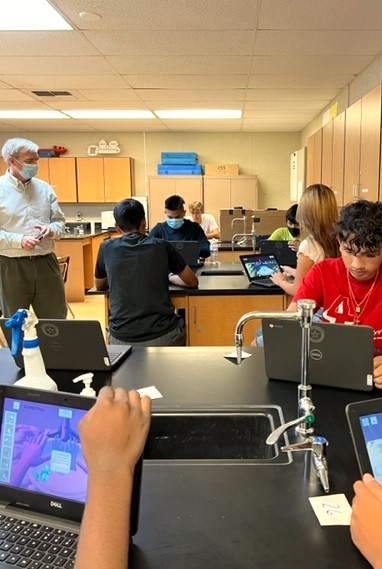
Schools are dynamic environments where children and educators come together to learn, play, and work. However, these very interactions also create opportunities for the spread of germs and infections. How is that possible? Students share desks, supplies, and meals, and engage in group activities. As a result, schools can become hot-spots for the transmission of bacteria and viruses. For that reason, understanding how germs spread in schools and implementing effective hygiene practices is crucial to maintaining a healthy learning environment.
The Science Behind Germ Transmission: How Infections Spread
For an infection to occur, three essential elements must be present:
1. A Source (The Reservoir): Germs exist on (and in) people, surfaces, and in the environment. Germs are part of our daily lives. While most germs are helpful, some may be harmful. In schools, common sources of germs include shared desks, doorknobs, lunch tables, water fountains, books, and even human skin and clothing. Some infections originate from so called “asymptomatic carriers”—students or teachers who may not feel sick but still carry and spread germs.
2. A Susceptible Host: While anyone can become infected, children tend to be more vulnerable due to their developing immune systems. In addition, children also have more frequent hand-to-mouth behaviors. Those with underlying health conditions or weakened immune systems are usually at higher risk for catching an infection.
3. A Mode of Transmission: Germs need a way to move from one person or surface to another. Thus, understanding these transmission routes allows schools to adopt targeted measures to prevent infections and their spread.
Primary Ways Germs Spread in Schools
1. Airborne and Droplet Transmission
Airborne and droplet transmission occurs when an infected person coughs, sneezes, talks, or even breathes, releasing respiratory particles. Those particles may contain viruses or bacteria. Large droplets tend to fall onto nearby surfaces or people, while smaller aerosolized particles can remain suspended in the air for longer periods of time, and travel greater distances. Although, the physics behind this is quite complicated and depends on many variables.
Common infections that spread this way, for example, include common cold, influenza, COVID-19, tuberculosis, and measles.
Prevention Strategies:
- Ensure adequate classroom ventilation by opening windows, using HEPA air filters, or enhancing HVAC systems.
- Encourage proper respiratory hygiene, such as coughing or sneezing into a tissue or elbow.
- Promote the use of masks during flu season or when outbreaks occur.
- While hand hygiene plays a role in controlling airborne diseases, reducing contaminated surfaces can further minimize transmission.
2. Direct Contact Transmission
Certain infections spread through skin-to-skin contact, where bacteria, viruses, or fungi pass directly from one person to another. This often happens during high-contact activities such as sports, recess, or shared group work.
Common infections that spread this way for example, include: Hand, Foot, and Mouth Disease (HFMD), impetigo, ringworm, and scabies.
Prevention Strategies:
- Encourage students to wash their hands frequently, especially after physical activities.
- Teach children the importance of personal space and avoiding unnecessary physical contact when sick.
- Additionally, ensure gym mats, sports equipment, and shared items are cleaned regularly.
3. Surface (Fomite) Transmission
Fomite transmission occurs when germs survive on objects and surfaces, and individuals touch these contaminated surfaces and then touch their eyes, nose, or mouth. Alongside that, schools, with their high-touch areas like desks, light switches, door handles, and shared supplies, are prime locations for fomite transmission.
Common infections that spread this way for example, include: common cold, Norovirus, RSV (Respiratory Syncytial Virus).
Prevention Strategies:
- Implement daily cleaning and disinfection of frequently touched surfaces.
- Encourage proper hand hygiene before and after using shared items.
- In addition: provide easy access to hand sanitizer stations throughout the school.

4. Foodborne and Waterborne Transmission
Germs that cause gastrointestinal infections can spread through contaminated food, beverages, or water. For this reason, these infections typically result from improper food handling, poor hand hygiene, or exposure to unclean water sources.
Common infections that spread this way for example, include: Salmonella, E. coli, Hepatitis A.
Prevention Strategies:
- Educate students and staff about the importance of washing hands before eating and after using the restroom.
- Ensure proper food safety measures in school cafeterias, including thorough cooking and proper food storage.
- Provide access to clean drinking water and encourage the use of personal water bottles to avoid cross-contamination.
5. Vector-Borne Transmission
Although less common in schools, some infections can spread through bites from insects such as mosquitoes, ticks, or lice. Head lice infestations, for example, are a frequent concern in school settings.
Common Infections Spread This Way: Head lice, Lyme disease (ticks), West Nile virus (mosquitoes).
Prevention Strategies:
- Conduct routine head lice screenings, particularly in younger age groups.
- Educate students about personal hygiene and avoiding shared hats, brushes, and scarves.
- Use pest control measures if necessary.
Factors That Contribute to Disease Spread
Several factors make schools an ideal breeding ground for the rapid spread of infectious diseases:
a. Close Contact & Crowded Spaces
Schools are densely populated environments where students spend long hours together in classrooms, cafeterias, and playgrounds. Close physical proximity increases the likelihood of diseases spreading from person to person.
b. Inconsistent Hygiene Practices
Young children, in particular, may not always follow proper hygiene practices, such as washing hands after using the restroom or covering their mouths when coughing or sneezing. This oversight can significantly contribute to the spread of germs. Schools can mitigate this by teaching proper hygiene habits from a young age.
c. Shared Supplies & Equipment
From books and pencils to gym equipment and computers, shared school items are common sources of indirect transmission. Encouraging individual supplies and regularly disinfecting shared items can help prevent the spread of germs and infectious diseases.
d. Poor Ventilation
Inadequate airflow in classrooms can allow airborne pathogens to linger, increasing the risk of respiratory infections. Schools should prioritize ventilation systems, ensuring that classrooms are well-ventilated and that fresh air circulates regularly.
e. Weakened Immunity
Children with developing immune systems or underlying health conditions are more susceptible to infections. This makes it even more important to maintain a healthy school environment where transmission risks are minimized.
f. Other Contributing Factors
Additional factors include students or staff attending school while sick, a lack of cleaning and disinfection routines, and insufficient handwashing facilities.
Strategies to Prevent Disease Transmission in Schools
a. Proper Hand Hygiene
Teaching students to properly wash their hands with soap and clean running water can go a long way in preventing disease spread. Schools should provide hand sanitizers in classrooms and at entryways to ensure easy access.
b. Respiratory Hygiene
Encouraging students to cover their mouths with tissues or their elbows when coughing or sneezing, and properly disposing of used tissues, can reduce the transmission of airborne diseases.
c. Regular Cleaning & Disinfection
Schools should implement regular cleaning schedules for frequently touched surfaces, such as desks, doorknobs, and cafeteria trays, to reduce the risk of surface-based transmission.
d. Improve Air Quality
To improve ventilation, schools should open windows when possible, use air purifiers, and ensure HVAC systems are well-maintained. This helps prevent the buildup of airborne pathogens.
e. Enforce Sick Policies
Enforcing strict sick policies ensures that students and staff exhibiting symptoms of illness stay home. This reduces the risk of exposing others and breaking the chain of transmission.
f. Encourage Vaccinations
Promoting recommended vaccinations can reduce the spread of vaccine-preventable diseases in the school community.
g. Educate Students & Staff
Conducting awareness programs about proper hygiene, food handling, and infection prevention practices ensures that everyone in the school community is informed and empowered to take steps to reduce disease transmission.
The Critical Role of Hand Hygiene in Infection Prevention
Among all infection prevention strategies, hand hygiene remains one of the most effective and simplest ways to reduce the spread of germs in schools. Research consistently shows that proper handwashing with soap and water can significantly lower the risk of illness. When soap and water are not available, alcohol-based hand sanitizers (containing at least 60% alcohol) are a good alternative.
Hand hygiene is particularly important after:
- Using the restroom.
- Blowing the nose, coughing, or sneezing.
- Touching shared objects such as classroom supplies, doorknobs, or electronic devices.
- Handling food or eating.
- Engaging in physical activities.
School-Wide Hand Hygiene Strategies:
- Install handwashing stations in high-traffic areas.
- Make hand sanitizers readily available in classrooms and common areas.
- Integrate hand hygiene education into the curriculum, using games, posters, and fun activities to encourage compliance.
Final Thoughts: Creating a Culture of Hygiene in Schools
Preventing the spread of infections in schools requires a multi-faceted approach that includes hand hygiene, proper ventilation, routine cleaning, and educating students on best health practices. By promoting a culture of hygiene and wellness, schools can significantly reduce absenteeism, improve student and staff health, and create a safer learning environment.
Ultimately, consistent handwashing, combined with targeted strategies for airborne, contact, and foodborne transmission, is key to keeping students and teachers healthy throughout the school year. By fostering hygiene habits early, we equip children with lifelong skills that will benefit them far beyond the classroom.
Dr. Jasminka Vukanovic-Criley MD, FACP, FHM is a multiple award-winning physician, internist, hospitalist, healthcare & education innovator & Associate Clinical Professor of Medicine at UCLA. She is a career mentor & advisor to numerous undergraduate, graduate & postgraduate students & faculty. As a researcher, Dr. Criley received awards from the National Institutes of Health & the U.S. Department of Education Her work focuses on creating research-driven #edtech games & digital media to improve health, civics, science education & promote healthy habits. Dr Criley is also a sought-after speaker & a founding Board member of Physician’s Weekly. She can be reached on X at @criley_md and at www.linkedin.com/in/jasminka-criley-md